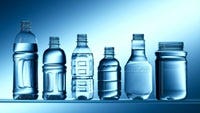Sign up for the PlasticsToday NewsFeed newsletter.
Sponsored By
Barrier coating gets FDA approval
The Enviroclear barrier coating technology has successfully completed the FDA’s Food Contact Notification process. Enviroclear partners Container Corp.
Tony Deligio
March 18, 2009
2 Min Read

When applied to a 500-ml polyethylene terephthalate (PET) or polypropylene (PP) bottle, Enviroclear reportedly provides an oxygen barrier of 42 times the level for uncoated PET.
The Enviroclear barrier coating technology has successfully completed the FDA’s Food Contact Notification process. Enviroclear partners Container Corp. of Canada (Toronto, ON) and The Council for Scientific and Industrial Research (CSIR) of South Africa say the barrier coating extends plastic packaging shelf life by reducing oxygen penetration and carbon dioxide loss.Norman James Gottlieb, Container Corp. CEO, told MPW his company believes the Enviroclear technology will allow a treated bottle to substitute a 12-oz can and “have a very acceptable shelf life of at least one year, which is probably more than the soft drink bottlers require.” For a 2-liter bottle, the shelf life would be longer.
Gottlieb said the coating is composed of PVA, Gantris, and other trace chemicals, all of which are approved by the FDA for food contact. It can be applied by dip coating, cascading, flow coating, or spraying, and the approximate cost/bottle based on a 500-ml size is .4 to .75 cents, depending on surface area. That figure does not include capital equipment, which can be amortized over 10 years.
When applied to a 500-ml polyethylene terephthalate (PET) or polypropylene (PP) bottle, Enviroclear reportedly provides an oxygen barrier of .001 cc/package/day, which is 42 times the level for uncoated PET. In a 12-oz PET carbonated soft drink bottle, the barrier improvement factor (BIF) is 6.4 times for carbon dioxide retention compared with a standard PET bottle. Container Corp. says the commercial carbon dioxide barrier extends shelf life 6.4 times, with oxygen barrier levels that are reportedly 10 times those of EVOH. Performance is said to be the same in PET or polyolefins, and the technology allows colors to be added. The company says the carbon dioxide barrier has been in limited commercial use on PET and PP bottles for more than three years without adhesion issues, and the fastest estimated projections have barrier-coating applications running at up to 28,000 bottles/hr.
Enviroclear has been successfully applied to plastic closures, thermoformed tubs, and other forms of packaging with the same results found in plastics bottles. Enviroclear is targeting hot-fill oxygen sensitive bottles for single-serve juice and beer, as well as other glass replacements. Container Corp. of Canada can supply bottle blowing and application equipment for the Enviroclear Barrier System, as well as licenses for the technology. The company is also working on a two-stage injection stretch blowmold process for clarified PP bottles and wide-mouth jars that it says have the clarity of glass, as another alternative for hot-fill barrier packaging. —[email protected]
About the Author(s)
You May Also Like


